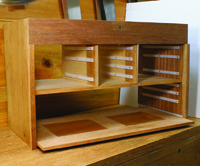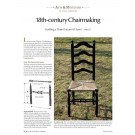We may receive a commission when you use our affiliate links. However, this does not impact our recommendations.
 I used plywood for my “Machinist’s Tool Test” project (in the October 2012 issue, and continued in February 2013 issue). In the past, I regarded plywood as being unworkable by hand. But I found a couple tricks to working it by hand:
I used plywood for my “Machinist’s Tool Test” project (in the October 2012 issue, and continued in February 2013 issue). In the past, I regarded plywood as being unworkable by hand. But I found a couple tricks to working it by hand:
• Plywood can be sawn using fine-toothed handsaws. I think crosscut saws work a little better than rips, because they leave a smoother edge and don’t tear the bottom face sheets quite so much. But whatever saw you use, I found it best to deeply score both sides of the sheet before attempting a cut.
• You can plane edges and the face of plywood. You need a very sharp iron and I found that the glue dulled my plane blades pretty quickly. I used metal-soled planes to avoid damaging the soles of my woodies.
• High-quality Baltic birch plywood, available from Woodcraft and other online suppliers, is easier to work by hand than the home center stuff. The face sheets are thicker, giving you more opportunity to surface plane it. It typically has more plies and fewer voids than run-of-the mill stuff, making it easier to edge plane.
When I build things for myself, I always seek to learn something new. For me, the finished projects are secondary to the journey. The Machinist’s Tool Chest project presented me an opportunity to commune with the rest of the woodworking universe. I wanted to integrate modern materials, specifically plywood, and stretch my own skill base in the same way I ask you to stretch yours. Like those of you who dabble in period work, I’ve attempted to build something outside my comfort zone without the appropriate tools and approaches. I think I now better understand what you are up against. I still believe all woodworkers should possess basic hand skills. But I’m less willing to suggest, as I think I have in the past, that the 18th c methods are suitable for practically any woodworking situation. Modern woodworking and period woodworking just aren’t similar.
— Adam Cherubini
 Check out Adam’s many, many projects and PDF downloads at ShopWoodworking.com.
Check out Adam’s many, many projects and PDF downloads at ShopWoodworking.com.
Here are some supplies and tools we find essential in our everyday work around the shop. We may receive a commission from sales referred by our links; however, we have carefully selected these products for their usefulness and quality.









While I attempt to use solid wood and hand tools for most everything I build, what I build for shop use is another story. I use what is the cheapest, most available and practical material for shop projects. Sooo, lots of plywood from the home center and I use one of the few power tools I have left, my 50 year old Craftsman 7 1/4″ power saw. Other than my workbench, there is not one “furniture” item in my shop that would ever show up in a woodworking magazine but they are all wonderfully useful, practical and low cost and did not take much time to build.
Thanks for your great articles,
Cosmo
Given that plywood isn’t a fine furniture wood, or an 18th century material (sure, it was around since the Egyptians but I’ve not seen it used in good furniture), fine furniture and 18th century techniques don’t apply, I agree.
18th century tools and techniques are suitable for any project utilizing 18th century materials or design. Past that, I agree with you. Plywood isn’t a fine furniture material, so fine furniture techniques don’t really apply.
Really looking forward to seeing the second half of this article, Adam. I think I’m going to have to try the plastic approach to drawer runners on the cabinet I’m working on.
I’ve been working a bit of ply occasionally, where I was being lazy. Got a good deal on some offcuts of the quality stuff from the lumberyard and use it for some panels in some shop stuff.
I work w/hand tools both for similar reasons to you, and because it’s really the only approach that’s compatible with working in the spare bedroom of my apartment. So working ply by hand was an interesting challenge. Your observations echo mine – be ready to sharpen your plane blades (perhaps that PMV11 stuff might have a use for me) if you’re working the edges, that’s for sure.
After having to sharpen up my saw a couple times, I went with an impulse-hardened Japanese style saw (the same one LV sells) it’s been holding up quite well, although I did find I had to stone a bit of the set off of it. It took a little getting used to figuring out how to cut sheet goods on the pull stroke, but I’ve made twice as many cuts with it and not had to sharpen the thing, and the deeper gullets seem to keep it from gumming up when cutting through glue-heavy sections.
Thin plane settings are a must planing the face – the rotary cut of many ply veneers makes for some interesting grain directions, at least in the pieces I’ve worked.
The key for me was finding ways to hide the edges of the ply not by capping it with something, but by trapping it in grooves and such – it allowed me to get away with “straight enough” rather than dulling all my tools getting it perfect.